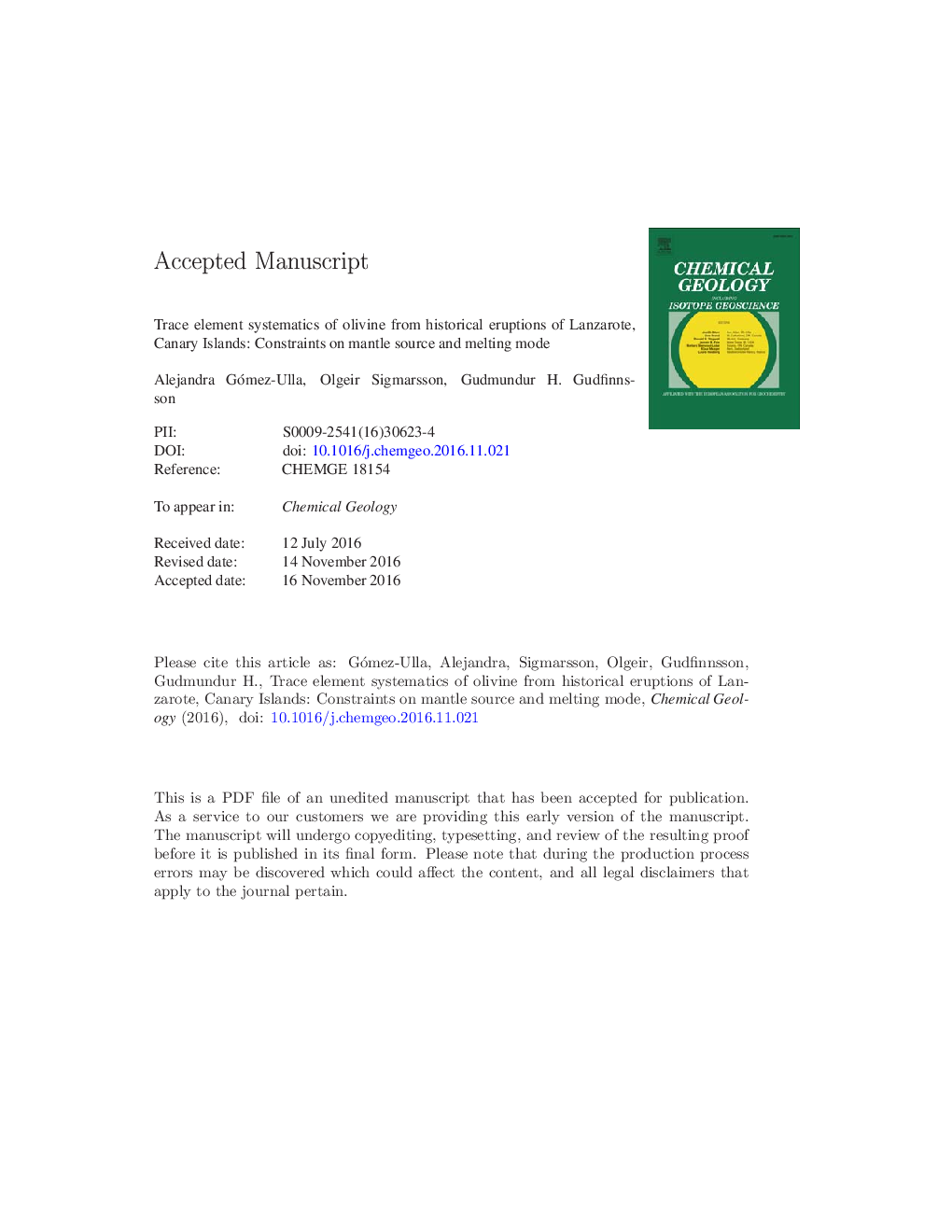| کد مقاله | کد نشریه | سال انتشار | مقاله انگلیسی | نسخه تمام متن |
|---|---|---|---|---|
| 5782782 | 1637525 | 2017 | 39 صفحه PDF | دانلود رایگان |
عنوان انگلیسی مقاله ISI
Trace element systematics of olivine from historical eruptions of Lanzarote, Canary Islands: Constraints on mantle source and melting mode
ترجمه فارسی عنوان
سیستم عاملی عنصر رقیق الیوین از فورانهای تاریخی لانزروت، جزایر قناری: محدودیت ها در منبع گوشته و حالت ذوب
دانلود مقاله + سفارش ترجمه
دانلود مقاله ISI انگلیسی
رایگان برای ایرانیان
کلمات کلیدی
لانزاروت، فوران 1730 تا 1736، فوران 1824، عنصر ردیابی، اولیوین، پریدوتیت، پیروکسنیت، دی اکسید کربن،
موضوعات مرتبط
مهندسی و علوم پایه
علوم زمین و سیارات
ژئوشیمی و پترولوژی
چکیده انگلیسی
Oceanic island basalts are thought to originate from partial melting of lithologically heterogeneous mantle. Sobolev and coworkers proposed the use of fractionation-corrected Ni concentration Ni Ã (FeO/MgO) and Fe/Mn measured in olivine as indicators of pyroxenite-derived component in mixtures of primary melts. Trace element concentrations were measured in olivine from two historical eruptions in Lanzarote (Canary Islands), which erupted mafic and mantle nodule bearing magmas, ranging in composition from highly silica-undersaturated basanites through alkali basalts to tholeiites. Tephra from each of the five eruption phases of the 1730-36 CE Timanfaya eruption contains olivine phenocrysts with cores with restricted Fo variation (~ 3 mol%), whereas trace element concentrations and ratios vary by a factor of approximately two. The largest variation is observed in early basanites with later eruption phases producing olivine macrocrysts containing trace elements within that range. Ni Ã (FeO/MgO) and Fe/Mn of olivine in the basanites span the whole range of olivine in MORB and OIB worldwide, whereas the olivine of subsequent phases has values akin to those crystallized from pyroxenite melts. The Fo content decreases systematically with time during the 1730-36 eruption and the proportion of silica-saturated primary melt increased in the parental magma mixture with time. At the end of the eruption, tholeiite magmas crystallized olivine with lower Fo content, whereas the concentrations of Mn and Ca increased together with Ca/Al at relatively uniform Ni Ã (FeO/MgO) and Fe/Mn, all of which is readily explained by increased decompression melting at lower temperature. The basanite from the eruption that took place in 1824 CE has olivine with even higher Fo content and trace element variability similar to that of the Timanfaya basanite. The fact that the Lanzarote basanites contain olivine with trace element systematic spanning that of MORB and pyroxenite melt can be explained by CO2-flux melting of a lithologically heterogeneous source, generating the diverse compositions. Alternatively, reactive porous flow through depleted oceanic lithosphere and equilibration with dunitic restite caused Ni depletion of percolating pyroxenite melt from which olivine of the basanites crystallized. The fact that olivine compositions and basanite magma were reproduced approximately a century later may reflect episodic carbonatic fluxing in the slowly uprising Canarian mantle plume.
ناشر
Database: Elsevier - ScienceDirect (ساینس دایرکت)
Journal: Chemical Geology - Volume 449, 20 January 2017, Pages 99-111
Journal: Chemical Geology - Volume 449, 20 January 2017, Pages 99-111
نویسندگان
Alejandra Gómez-Ulla, Olgeir Sigmarsson, Gudmundur H. Gudfinnsson,
